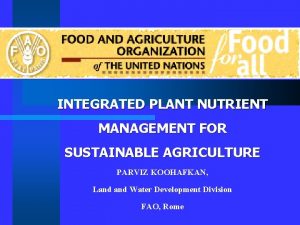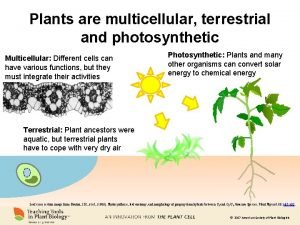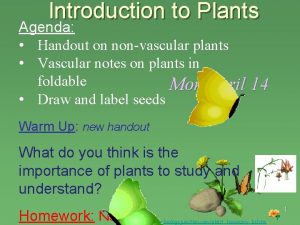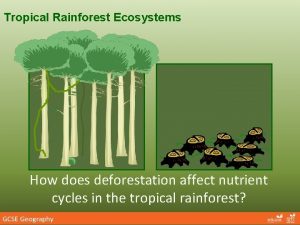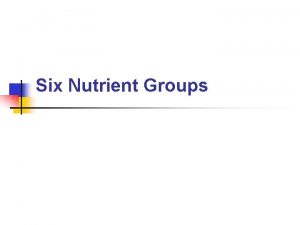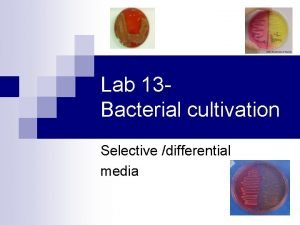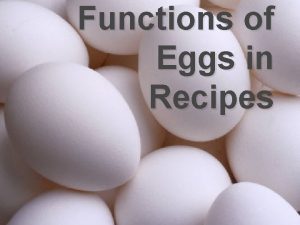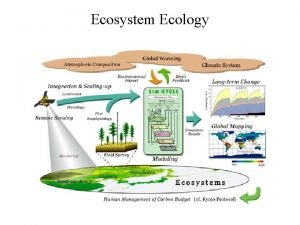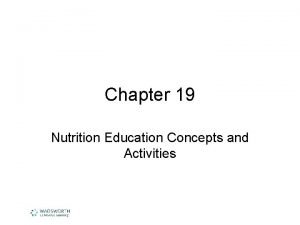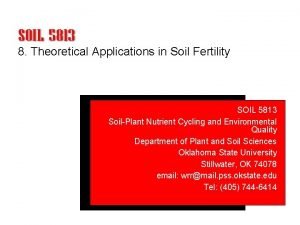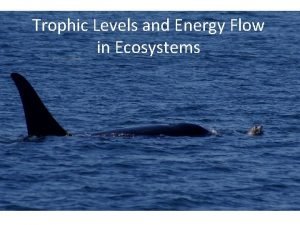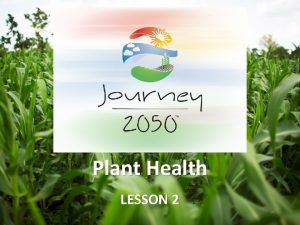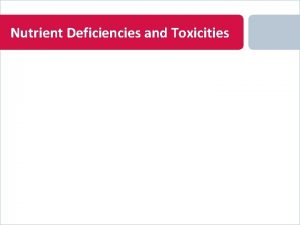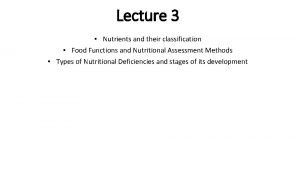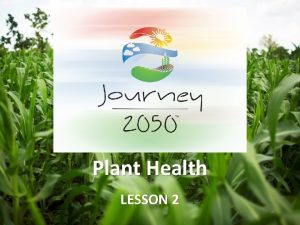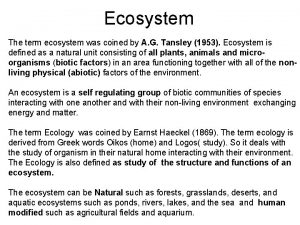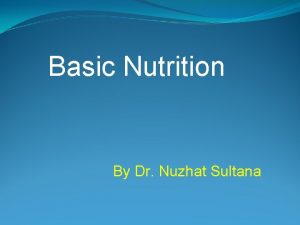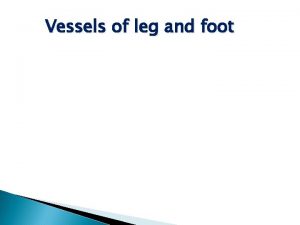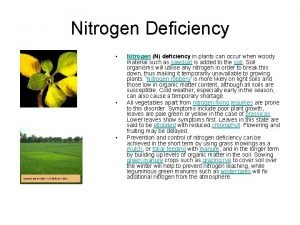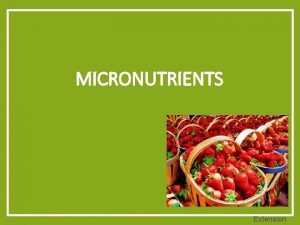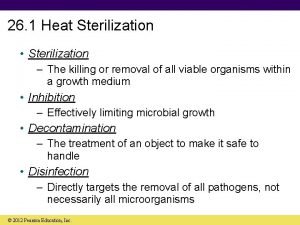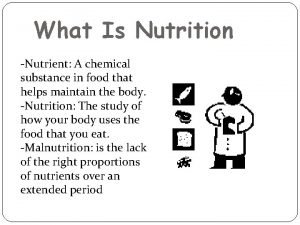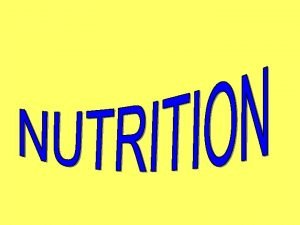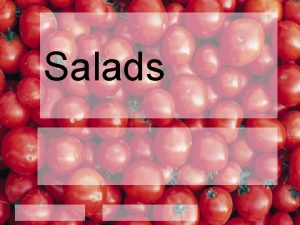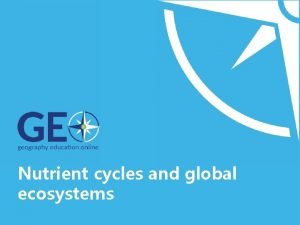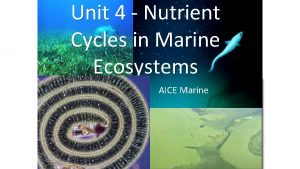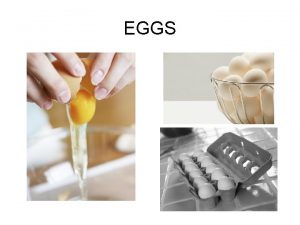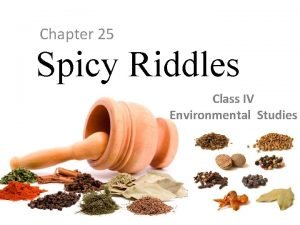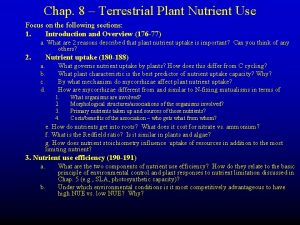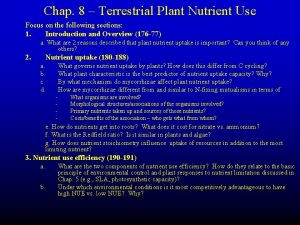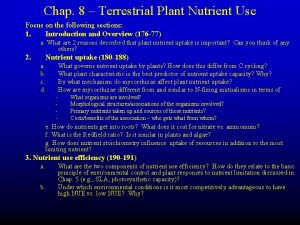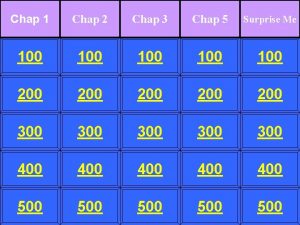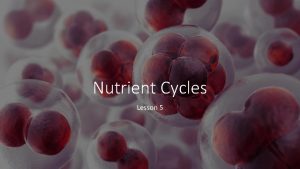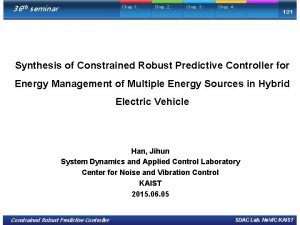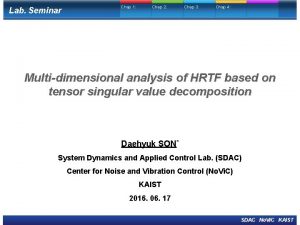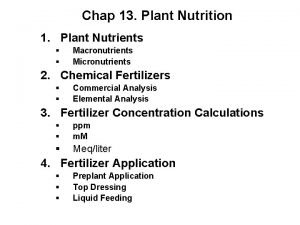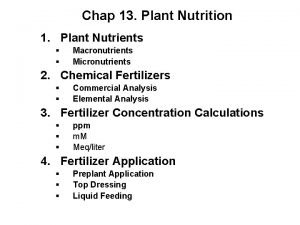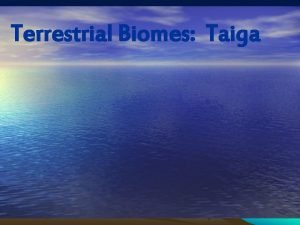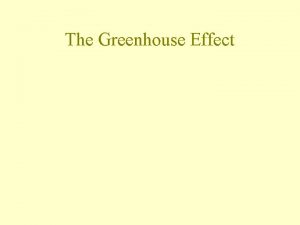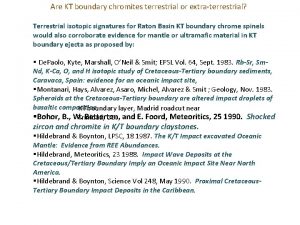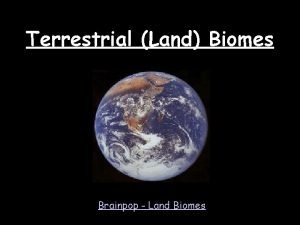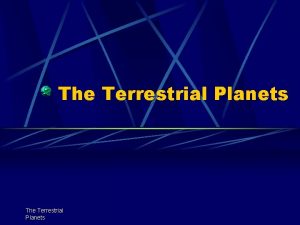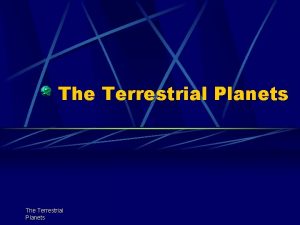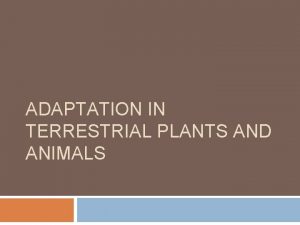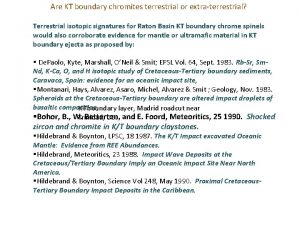Chap 8 Terrestrial Plant Nutrient Use Focus on














































- Slides: 46

Chap. 8 – Terrestrial Plant Nutrient Use Focus on the following sections: 1. Introduction and Overview (176 -77) a. What are 2 reasons described that plant nutrient uptake is important? Can you think of any others? 2. Nutrient uptake (180 -188) a. b. c. d. What governs nutrient uptake by plants? How does this differ from C cycling? What plant characteristic is the best predictor of nutrient uptake capacity? Why? By what mechanism do mycorrhizae affect plant nutrient uptake? How are mycorrhizae different from and similar to N-fixing mutualisms in terms of - What organisms are involved? Morphological structures/associations of the organisms involved? Primary nutrients taken up and sources of those nutrients? Costs/benefits of the association – who gets what from whom? e. How do nutrients get into roots? What does it cost for nitrate vs. ammonium? f. What is the Redfield ratio? Is it similar in plants and algae? g. How does nutrient stoichiometry influence uptake of resources in addition to the most limiting nutrient? 3. Nutrient use efficiency (190 -191) a. b. What are the two components of nutrient use efficiency? How do they relate to the basic principle of environmental control and plant responses to nutrient limitation discussed in Chap. 5 (e. g. , SLA, photosynthetic capacity)? Under which environmental conditions is it most competitively advantageous to have high NUE vs. low NUE? Why?

Trophic Interactions and Secondary Production Reading: CMM Chap. 11 A. Food webs 1. Food chains 2. Food chains vs. food webs 3. Linked webs B. Energy budget 1. Energy loss 2. Ecological pyramids C. Ecological efficiency of energy transfer 1. The arithmetic 2. Controls on Trophic Efficiencies a. Consumption b. Assimilation c. Production D. Ecosystem consequences 1. Food chain length 2. Top-down vs. bottom-up control of production 3. Herbivory effects on nutrient cycling E. Stable isotopes and food webs

Where does the energy come from that fuels ecosystems? What is the fate of that energy? How does it affect the distribution and abundance of organisms of different types? What are the controls on heterotrophic production?

A. Food webs 1. Food chains a. Primary trophic levels Primary producers, herbivores, carnivores (predators), omnivores, detritivores b. linear connections between trophic levels. c. Both detrital and grazing food chains.

2. Food chains vs. food webs Food webs: -Nonlinear -Omnivory blurs trophic levels

Most food webs are oversimplified - can quantify effects by interaction strengths. - only strongest interactions are often shown - interaction strengths can vary with environment Top down vs. bottom-up control? Simplified food web Molles 2004

Most food webs are oversimplified - Analysis of food webs, usefulness for determining species interactions, depends on level of resolution.

3. Linked food webs Grazing and detrital chains are linked

B. Energy Budget: Source and fate of energy (Molles 2004)

B. 1. Fate of energy Points: 1. Energy flow is one-way - once used, it is dissipated as heat 2. GPP > NEP 3. Most energy taken in by consumers is lost to respiration.

B. 2. Trophic pyramids Rule of thumb: 10% energy transfer between trophic levels Classic food chain

Trophic energy losses: a Michigan old-field Very little NPP becomes animal biomass

Inverted trophic pyramids Biomass at each trophic level carnivores herbivores 1 o producers Can this ever happen with pyramids based on energy flow (productivity)?

Inefficiencies of food chains result in energy pyramids 11. 8

Very little NPP becomes animal biomass 11. 7

C. Ecological Efficiencies of energy transfer Why is biomass of animals so small? Where does all the energy go? Why is transfer efficiency so low?

C. 1. The Arithmetic Availability of energy for growth So, P = C - R - F - U Assim. Production Consumed 1 o Prod Respiration Assimilated Consumed Feces Urine Unconsumed

Availability of energy for growth: Depends on efficiency of transfer Trophic efficiency = In/Pn-1 * An/In * Pn/An = Pn/Pn-1 Production efficiency = Pn/An Assim. Production Respiration Assimilation efficiency = An/In Consumed Assimilated Feces Urine Consumption efficiency = In/Pn-1 1 o Prod Consumed Unconsumed

C. 2. Controls on trophic efficiencies a. Consumption efficiency Table 11. 1. Consumption efficiency of the herbivore trophic level in selected ecosystem types.

Consumption vs. NPP Food quality Differences among biomes

Factors governing consumption efficiency • 1. Plant quality – Depends on resource supply and species – Plant allocation to structure – Plant defense (p. 248 -249) – Herbivores vs. carnivores

Factors governing consumption efficiency 1. Plant quality 2. Activity budget of animal – Selection of habitat – Time spent eating • Animals do many other things (avoid predators, reproduction, etc. ) – Selectivity of plants and plant parts

Factors governing consumption efficiency • 1. Plant quality • 2. Activity budget of animal • 3. Abundance of consumers relative to producers

b. Assimilation Efficiency Assimilation, production, and growth efficiencies for homeotherms and poikilotherms Smith (1998) Table 11. 3, p. 181, See also CMM Table 11. 2

Assimilation efficiency depends on: • Food quality – (e. g. , summer vs. winter diet of hares) • Physiology of consumer - homeotherm vs. heterotherm (warmer, more constant gut temperature)

Table 11. 2 c. Production efficiency (Pn/An) Depends mainly on the metabolism of the animal (homeotherm vs. heterotherm, body size)

D. Ecosystem consequences 1. Food chain length? Secondary Production vs. NPP

Greater production can lead to more trophic levels. Molles 2004

But, NPP is not the only constraint on animal production 11. 3 - Control of predation, disease, supplemental water, supplemental minerals in managed ecosystems.

Bottom-line: no simple correlation across ecosystems in NPP and food chain length • Other factors (environmental variability, habitat structure) can be strong. • Excess nutrients/production can change community composition to dominance by well-defended species (e. g. , aquatic systems).

2. Trophic cascades -Odd numbers – green world, even numbers – bare -Implies strong top-down controls

Trophic cascades • Depend on strong interactions among a few dominant species • Tough to use in management – predicting species interactions is difficult! Simplified food web

Trophic Cascade and Fertilization Schindler et al. 1997

3. Herbivory effects on N cycling Herbivory magnifies effects of differences in soil fertility on decomposition and mineralization

E. Using stable isotopes to understand food webs 1. Carbon – You are what you eat – Mixing models – “Mixing muddles” – Other isotopes 2. Nitrogen – You are what you eat, less what you excrete. – Trophic relationships Following figures from Fry (2006) Stable Isotope Ecology. Springer.

1. Carbon: You are what you eat. Fig. 5. 4. Conceptual model of carbon flow in the Texas seagrass meadows, with only two carbon sources present, seagrass and phytoplankton (P. L. Parker, personal communication, ca. 1976).

Carbon signatures depend on food source Fig. 5. 6. Histogram of carbon isotopes in plants and consumers from seagrass meadows of the Upper Laguna Madre (dark) and from the offshore Gulf of Mexico (white). Phytoplankton inputs dominate in the offshore ecosystem, while values are shifted away from the phytoplankton values towards seagrass values in the Upper Laguna Madre (from Fry and Parker 1979).

Mixing models determine % contribution of different sources Fig. 5. 11. Mixing models for percentages, nitrogen and carbon isotopes – blue and yellow sources at the ends of the scales yield a green sample in the middle; colors and isotopes index the % contributions of the sources, 50% - 50% in these cases.

Fig. 5. 13. Mixing models – two sources at the ends and a sample in the middle; sources contribute unequally to the sample in the top and bottom case, so the split is not 1: 1, but 2: 8 (top, blue source is larger contributor) and 1: 9 (bottom, yellow source dominates). In these two-source mixing problems, source 1 contributes fraction f 1 and source 2 contributes fraction f 2 to the mixed intermediate sample so that f 1 + f 2 = 1, f 2 = 1 - f 1 and as derived in section 5. 3, f 1 = (d. SAMPLE – d. SOURCE 2)/(d. SOURCE 1 -d. SOURCE 2).

Mixing muddles – what happens when you add another source? Fig. 5. 8. Conceptual mixing models for carbon isotopes. Our seagrass research started with the a two-source model (Model A) with -20 o/oo phytoplankton and -10 o/oo seagrasses contributing 50/50 to -15 o/oo consumers (open circles; closed circles are sources). But further work changed the picture. Especially discovery that marine macroalgae had intermediate -15 o/oo isotope values. This complicated interpretation of the isotope results (model B), creating a “mixing muddle” with no unique solution, i. e. , source contributions of 50/0/50 and 0/100/0 were both logically possible. To resolve this muddle, we turned to observational studies, comparative isotope surveys, and more tracers, as explained in the text. (Adapted from Fry and Sherr 1984; used with permission from Contributions in Marine Science).

Other isotopes Fig. 5. 12. As Fig. 5. 11, but for sulfur, oxygen and hydrogen stable isotopes.

Using additional isotopes 3 equations, 3 unknowns (f 1, f 2, f 3) Fig. 5. 17. Mixing models and muddles. Bottom graph shows mixing muddle where there are three sources and no unique solution for source contributions to the sample, which is shown as a filled triangle and sources are depicted as squares. To resolve the muddle, one can measure another tracer, gaining resolution if lucky (left middle) or not gaining resolution if unlucky (right middle). A surer way to gain resolution is to add isotope artificially to one source (top). All sources contribute equally to the sample in these examples.

Fig. 5. 10. Dual-isotope, carbon-sulfur isotope diagram for the food web in seagrass meadows at Redfish Bay, Texas, sampled in 1980 (Fry, 1981). Rectangles indicate ranges of measured plant values in the case of seagrasses, macroalgae and epiphytes; offshore plankton values are estimates (Fry et al. 1987). The diamond symbols indicate isotope values for common consumers, including 4 shrimp species, blue crabs, snails, toadfish, pipefish and anchovies.

2. 15 Nitrogen and trophic levels -You are what you eat, minus what you excrete. +3. 4 %o per trophic level Fig. 3. 8. Effects of species introductions measured in lake ecosystems. Introduction of nearshore bass species forces the native top predator, lake trout, offshore. Reflecting this spatial displacement, lake trout diets shift towards feeding in a more pelagic food web (as measured by lower d 13 C) and at a lower trophic level (as measured by lower d 15 N; with d 15 N translated into the yaxis “trophic level” in this figure). Dietary shifts help explain the decline of lake trout in the invaded lakes. This figure summarizes results from comparative studies in different lakes and results for single lakes studied over time (from Vander Zanden et al. 1999; used with the permission of the author and Nature Publishing Group. Copyright 1999).

• • • Summary Interaction strengths tell who is eating who and how much. Can estimate contributions of major food sources by stable isotopes (sometimes). Grazing and detrital food webs interact. Energy loss at each trophic transfer. Consumption, assimilation, and production efficiencies determine amount of new biomass at each level. Trophic cascades only with comparatively simple ecosystems.

Molles fig. 18. 16 Molles fig. 17. 4 Molles fig. 18. 17 Molles fig. 17. 2
 Venkatraman ramakrishnan medium
Venkatraman ramakrishnan medium Chap chap slide
Chap chap slide Integrated plant nutrient system
Integrated plant nutrient system Photosynthetic multicellular and terrestrial
Photosynthetic multicellular and terrestrial Terrestrial plant
Terrestrial plant For adult
For adult Porters generic competitive strategies
Porters generic competitive strategies Cost leadership strategy
Cost leadership strategy Actor focus vs object focus
Actor focus vs object focus Branches of radial artery
Branches of radial artery Nutrient cycle of a tropical rainforest
Nutrient cycle of a tropical rainforest What are the six nutrient groups
What are the six nutrient groups Differential media
Differential media Example of egg dishes in emulsion
Example of egg dishes in emulsion Nutrient cycle in the serengeti
Nutrient cycle in the serengeti Deciduous woodland nutrient cycle
Deciduous woodland nutrient cycle Foods used in nutrition activities should be nutrient-dense
Foods used in nutrition activities should be nutrient-dense Bray nutrient mobility concept
Bray nutrient mobility concept Nutrient chain foldable
Nutrient chain foldable Journey 2050 student handout 2 word search
Journey 2050 student handout 2 word search Nutrient deficiency
Nutrient deficiency Nutrient basics
Nutrient basics 3 functions of nutrients
3 functions of nutrients Which nutrient practice was best journey 2050
Which nutrient practice was best journey 2050 The term ‘ecosystem’ was coined by *
The term ‘ecosystem’ was coined by * Defination of nutrient
Defination of nutrient Apes nutrient cycles
Apes nutrient cycles Nutrient artery
Nutrient artery Nutrient artery
Nutrient artery Tamoxifen nutrient depletion
Tamoxifen nutrient depletion Nutrient deficiency in tomatoes
Nutrient deficiency in tomatoes Nutrient interactions
Nutrient interactions Immobile nutrients
Immobile nutrients Nutrient agar plate
Nutrient agar plate Nutrition body
Nutrition body Nutrient substance
Nutrient substance What are the four types of salads
What are the four types of salads Nutrient cyle
Nutrient cyle Nutrient cycles in marine ecosystems
Nutrient cycles in marine ecosystems What nutrient cushions vital organs
What nutrient cushions vital organs Interfering agent eggs
Interfering agent eggs Nutrient chain foldable
Nutrient chain foldable 패션 chap 1
패션 chap 1 Passion chap 6
Passion chap 6 Bank run chap 11
Bank run chap 11 Assumptions of clrm gujarati
Assumptions of clrm gujarati Spicy riddles worksheet with answers
Spicy riddles worksheet with answers


